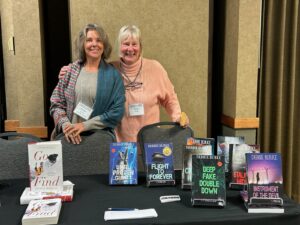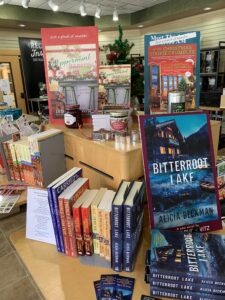Jordan Dane
@JordanDane

Purchased by Jordan Dane
I can’t think of a better way to settle in for Thanksgiving and the holidays than with a little murder among neighbors. For your reading enjoyment–and for your constructive criticism–we have the first 400 words of THE GOOD NEIGHBOR, submitted anonymously by a gutsy author and follower of TKZ. Read and enjoy. My feedback will be on the flip side.
***
The unusual heat wave which persisted over parts of New England, long after forecasters had predicted an early end to summer, gave many of the residents an irritable disposition.
The nights didn’t bring much in the way relief to the sweltering New Englanders, who looked forward to the cooler winds from the North by this time and the promise of fishing for those by Maine’s coastline.
Tonight at 12 Rillington Lane, Kennebunk, Kaitlyn O’Donnell struggled with the heat. She tossed, turned, rolled over, then repeated it all once more.
The blending of the weather, the cicadas and that infernal scraping noise—what the hell is that, anyway?—guaranteed sleep would not come tonight.
Frustrated, she threw the thin cotton sheet back and jumped out of bed.
A half-moon in the cloudless sky enabled Kaitlyn to see without the aid of electricity and she shuffled over to the window of her bedroom on the second floor.
The scraping, it sounded like it came from…
The neighbor’s backyard.
From her vantage point Kaitlyn spotted a light in the neighbor’s yard. She assumed a battery-powered lamp.
Silhouetted against the low-light, a male figure busied himself with a shovel.
Next to the hole he dug were two oblong objects encased in a light-colored fabric.
They were the length of —
Oh, my God. Bodies, he’s burying someone!
Kaitlyn’s eyelids flared as she stared with disbelief into her neighbors yard.
The neighbor stopped digging moments later and stood erect. In a deliberate motion, he turned to face the O’Donnell home.
He’s staring at me, oh my… he’s staring…
Kaitlyn’s blood, now like ice water, rushed through her veins.
Kaitlyn threw a cotton nightgown over her head and ran barefooted to the hallway. “Dad, Dad,” she called.
Bursting into her parents bedroom at the end of the hallway seconds later she called again. “Dad, wake up, there’s something’s—”
The double bed of Kaitlyn’s parents was empty, the top blankets thrown on the floor but the light colored sheets were missing.
She remembered the two object wrapped in light cloth in the neighbor’s yard.
A heavy banging on the front door echoed through the O’Donnell home.
“Kaitlyn? Oh, Kaitlyn.” A voice called. “It’s your neighbor, come on over, Kaitlyn. There’s always room for one more…”
FEEDBACK:
Aspects of this author’s style are vivid and have set the stage for the creepiness of this introduction. The voice here has promise, but there is a feeling that the story is being rushed toward the end and the author resorts to “telling” what is happening, which diminishes the tension and pulls the reader out from inside the head of Kaitlyn. I promise you, anonymous author, that if you truly stay in the head of this horrified kid, your readers will feel the tension and may suffer a rash of goosebumps if you take your time to set up this scene through Kaitlyn’s senses.
Also, it is not recommended to start stories with the weather. Plus, the Point of View (POV) in the first line (and in other spots) is omniscient and not from the main character. This is most evident with the weather description “gave many residents an irritable disposition,” rather than focusing on Kaitlyn’s perspective of HER being irritable with the pervasive heat.
The next line is clearly not in Kaitlyn’s POV either.
“The nights didn’t bring much in the way relief to the sweltering New Englanders, who looked forward to the cooler winds from the North by this time and the promise of fishing for those by Maine’s coastline.”
But without a major rewrite, let’s take a look at how we can use the bones of the author’s story and shuffle sentences to allow the focus to start and remain with Kaitlyn.
STORY SHUFFLE:
In this intro, the author states the physical address of the house where Kaitlyn lives, but doesn’t include the State of Maine until later, after a reference to New England (a region of six states). The reader could be oriented with a quick tag line at the top of the scene to list the town and the time of day. I like using tag lines to anchor the story and reader reviews have mentioned that they like this. In a book by Tami Hoag, she used the dropping temperatures in Minnesota during the hunt for a child exposed to a deadly winter. The added tension of knowing the weather could kill the child became an effective use of tag lines that made an impression on me. So this story could start with the tag lines:
REWRITE INTRO SUGGESTION
Kennebunk, Maine
After Midnight
A full moon cast an eerie shadow of an Eastern White Pine through Kaitlyn O’Donnell’s open bedroom window that stretched onto her walls. The swaying gloom played tricks on her mind and teased her fertile imagination. When the hot night air gusted, the spindly branches of evergreen bristles scraped the side of her house like clawing fingernails, grating on her frayed nerves.
The sixteen year old girl struggled with the unusual heat that smothered her skin like a thick, dank quilt. She tossed and turned and fought her bed sheets, struggling for any comfort that would allow her to sleep. Even if she could doze off, the annoying rasp of cicadas rose and fell to keep her on edge.
Sleep would not come–not tonight. Not when something else carried on the night air.
With sweat beading her arms and face, Kaitlyn tossed the sheet off her body and sat up in bed. Without thinking, she slid off her mattress and wandered toward the open window, drawn by an odd sound that caused the cicadas to stop their incessant noise.
In this new opener, the point of view is clearly in Kaitlyn’s head and her senses show the story of her restlessness and how her mind plays tricks on her. In her current state, she could’ve imagined what comes next.
TELLING – In the action that follows, the descriptions seemed rushed to me and the author resorts to “telling” what is happening, rather than showing. The following sentences are examples of “telling” or POV issues or rushing the story.
She assumed a battery-powered lamp. (It’s not important that the lamp is battery operated. No one spying on their neighbor at night will wonder about batteries. Keep it real and stay with the mystery and tension.)
Oh, my God. Bodies, he’s burying someone! (Give time for her to see shapes and describe them. She’s only watching from the light of one lamp and the neighbor is in silhouette. How well could she see the bodies? But in this case, the author gets impatient and has Kaitlyn “tell” the reader what’s happening.
He’s staring at me, oh my… he’s staring… (Same issue of “telling” the reader. In the dark and shadows, Kaitlyn might only see his body turn toward her. She can’t possibly know that he’s staring at her. But the author should consider giving the neighbor a reason to turn, like the sound of Kaitlyn calling for her dad. Her voice and an open window could allow the sound to carry. Kaitlyn’s sense of urgency could get her into trouble before she realizes she’s alone in the house. Much scarier.)
Kaitlyn’s blood, now like ice water, rushed through her veins. (Kaitlyn might have a rush of chilling goosebumps caused by an adrenaline rush in the sweltering heat, but the cliched “ice water through her veins” isn’t the best word choice.)
The double bed of Kaitlyn’s parents was empty, the top blankets thrown on the floor but the light colored sheets were missing. (Would Kaitlyn notice in the shadowy room that her parents light colored sheets were missing? A scared kid would notice her parents were gone, but never do an inventory of their bed sheets.)
She remembered the two object wrapped in light cloth in the neighbor’s yard. (Here, Kaitlyn even makes a big deal of tying the light colored sheets to what she saw in her parent’s bedroom. Not remotely realistic. By rushing the ending, the author has given up details and mystery elements, like whether there is blood spatter on the walls and bed or signs of a struggle. Two people being accosted in the middle of the night by a neighbor would surely leave signs of a struggle. And–how did the neighbor get into the house? Why didn’t Kaitlyn HEAR anything if she couldn’t sleep? This intro needs work to make it more plausible.)
THE RUSHED ENDING – The ending is especially rushed. A vital part of suspense is the element of anticipation (something Hitchcock knew well). As an example of this – picture a teen babysitter creeping toward the front door with every movie goer screaming at the big screen “DON’T OPEN THE DOOR!” Once the door is open, the tension is deflated and everything becomes known. To keep the tension building, add some level of detail to build suspense.
A heavy banging on the front door echoed through the O’Donnell home. (The neighbor presumably invaded Kaitlyn’s house to attack her parents or take them to bury in his yard. Why is he knocking this time?)
“Kaitlyn? Oh, Kaitlyn.” A voice called. “It’s your neighbor, come on over, Kaitlyn. There’s always room for one more…” (I don’t believe it’s necessary to have the neighbor say “It’s your neighbor.” He doesn’t need to give his name, because she would know it. So the dialogue here is a bit cheesy and definitely “telling.” Another question – if the neighbor killed her parents, why stop at them? Why not take Kaitlyn too?)
KEY WAYS TO GIVE THIS MYSTERY ROOM TO BREATHE
There’s not enough plausible motivation for this rushed story. If this is a mystery, the details that are not addressed deflates the suspense in a big distracting way. How did the man take her parents from their bed? Why didn’t she hear any struggle? Are their signs of a struggle in the bedroom?
The author has a good deal of fixing that needs to occur to make this intro believable. Key ways to give this mystery room to breathe – suggestions for improving this introduction (besides the ones I wrote about above):
1.) Have Kaitlyn awaken from a drugged stupor – was she drugged or did she take cold medicine to help her sleep that could’ve distorted her take on reality or stopped her from being aware of a struggle?
2.) Had Kaitlyn’s parents been next door at a party with the neighbor and never returned home? Maybe the intro could take place the next morning when she realizes her parents never came home. Their bed is unmade. No breakfast. She rushes to the neighbor’s house and he’s not home or lies to her about when her folks left. “They went straight home, honey.”
3.) Have her file a police report with no clues on how her parents disappeared and the cops are skeptical. She begins spying on the neighbor – as in REAR WINDOW. This plot has been done before, but the idea is to create a compelling mystery that readers care about. A teen alone to deal with her missing parents.
4.) Give the girl a handicap where she is wheelchair bound and reliant on her parents for care. Who would she go to for help?
5.) Make Kaitlyn a suspect in the eyes of the police. Maybe she is a rebellious kid who’s been suspended from high school for fighting. What has given her a big chip on her shoulder?
6.) Grow the Suspect List – After this rushed intro, where would the rest of the book go? If the author made a bigger mystery of whether the neighbor is involved at all, there could be others who had motive to eliminating her parents. A fun way to create and sustain a mystery is to reveal others with motives as the story unfolds. Make a list of 4-5 individuals who are equally guilty looking. Maybe even the author doesn’t know who the real killer is until the last minute. I did this in my debut book NO ONE HEARD HER SCREAM. I literally could’ve flipped a coin on which one of my 5 suspects could be guilty and I loved not knowing myself. But most importantly, having more than a crazy neighbor (who admits to guilt on the first page) allows the story plot to breathe and twist and build to a climax.
FOR DISCUSSION:
1.) What feedback would you give this author, TKZers?
2.) Can you suggest other plot twists than the ones I listed in my summary?






















 I live in a small tourist town in the northern Rockies. One of the downtown anchor businesses is a kitchen shop. My two cozy mystery series are both set in food-related retail shops, one here and one in Seattle’s Pike Place Market. It’s been a natural combination, and the kitchen shop sells dozens of my books every year to both locals and visitors. To my surprise, it’s also sold more than 100 copies of my first suspense novel, Bitterroot Lake, a hardcover without a single cupcake on the cover. Why? My guess: The bitterroot is the state flower and the word is echoed in landmarks throughout the area, giving it a strong regional appeal.
I live in a small tourist town in the northern Rockies. One of the downtown anchor businesses is a kitchen shop. My two cozy mystery series are both set in food-related retail shops, one here and one in Seattle’s Pike Place Market. It’s been a natural combination, and the kitchen shop sells dozens of my books every year to both locals and visitors. To my surprise, it’s also sold more than 100 copies of my first suspense novel, Bitterroot Lake, a hardcover without a single cupcake on the cover. Why? My guess: The bitterroot is the state flower and the word is echoed in landmarks throughout the area, giving it a strong regional appeal.
 BLIND FAITH (written as Alicia Beckman), is out October 11 from Crooked Lane Books, in hardcover, ebook, and audio.
BLIND FAITH (written as Alicia Beckman), is out October 11 from Crooked Lane Books, in hardcover, ebook, and audio.

